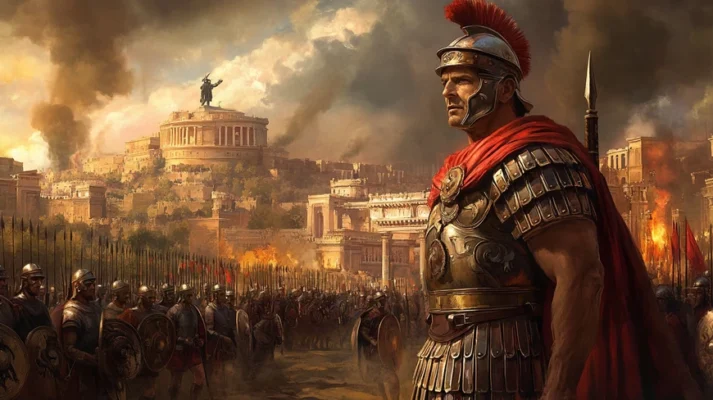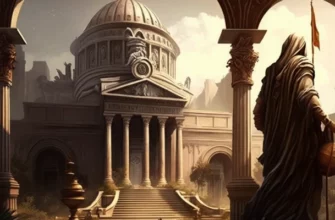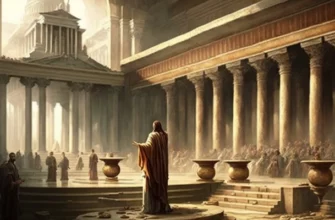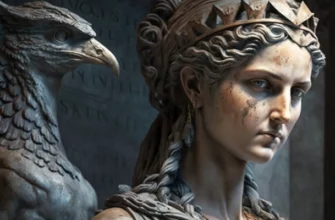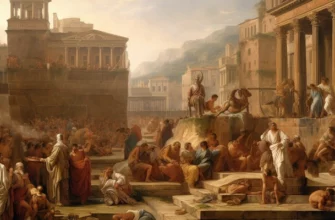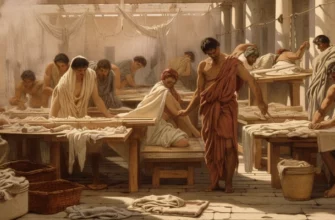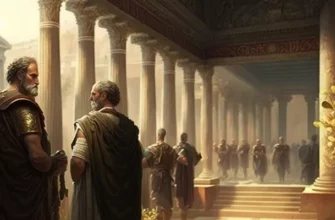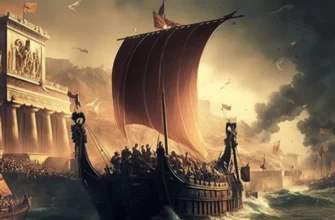The Roman Republic, which existed from 509 BC to 27 BC, was known for its political system based on the principles of balance of power distributed between the consuls, the senate, and the popular assemblies. However, a number of factors led to its transformation into an empire.
Political reasons. Over time, republican institutions became less and less effective. The power of the consuls and the Senate was often reduced due to struggles between different political groups. Conflicts between the patricians and plebeians, as well as internal power struggles, created conditions for strong personalities such as Julius Caesar to seize more and more political power. As a result, the political system of the republic began to collapse.
Social and economic factors. The huge economic gap between the rich and the poor became one of the main drivers of social unrest. Military campaigns in various parts of the world led to the rise of military leaders who used armies to gain political support. For example, Caesar, who was elected consul, gained the support of the troops, which allowed him to become a dictator.
Military role. Growing military power also contributed to political change. Military leaders such as Pompey and Caesar had a significant influence on the politics of the republic. This led to the army becoming more important than the Senate, and the personal ambitions of generals began to determine the direction of Roman politics.
Cultural and ideological changes. Over time, the ideas of the republic became less popular among the population. In the context of continuous wars and political instability, there was a need for a strong leader who would ensure stability. Octavian Augustus, after his victory in the civil war, became the first emperor of Rome, putting an end to republican rule.
The transition of the Roman Republic to an empire was a complex and multifaceted process that included political, economic, and military changes. This process not only changed Rome but also determined the course of world history for centuries to come.
- Political reasons for the transition
- Strengthening the power of consuls and dictators
- Internal political struggles and conflicts
- The collapse of republican institutions
- Social and economic factors
- Social inequality and conflicts between the patricians and the plebeians
- The military role in the transformation
- Cultural and ideological changes
- Conclusion
Political reasons for the transition
Rome’s transition from a republic to an empire was caused by a number of political reasons that undermined the stability of republican institutions and contributed to the growth of the personal power of individual leaders.
Strengthening the power of consuls and dictators
In the Roman republican system, consuls were elected for one year, which was supposed to ensure a balance of power.
However, over time, the position of consul became too important and influential, and constant wars and political crises required a strong leader who could act without restrictions. As a result, the republic gradually transitioned to a regime where a dictator, led by Julius Caesar, had unlimited power.
Internal political struggles and conflicts
Internal conflicts between different political groups, such as the optimates (aristocrats) and the populares (plebeians), led to constant instability. Ideas of equality and representation did not always find support in the Senate, which led to social unrest. These conflicts weakened political institutions, paving the way for the centralization of power.
The collapse of republican institutions
The Senate, which was originally the main governing body, became increasingly ineffective as its power gave way to the personal ambitions of political leaders. Military commanders with their own armies became the main political players. They began to use their troops to gain political support and control over the state. For example, after conquering Gaul, Julius Caesar turned his army into a powerful political force that allowed him to become a dictator.
The idea of “preserving the republic” through a strong leader
Due to constant political crisis and uncertainty, citizens began to support the idea that a strong leader was necessary for the stability of the state. This became the ideological justification for the transformation of the republic into an empire. Octavian Augustus, the last ruler who was able to stabilize the situation after numerous civil wars, consolidated authoritarian rule, preserving the appearance of republican institutions but effectively becoming emperor.
These political changes, in particular the strengthening of the power of individuals and the collapse of republican institutions, were the main reasons for the transition of the Roman Republic to an empire.
Strengthening the power of consuls and dictators
The Roman Republic had a well-developed system of government, where power was divided between different branches. Consuls, who were elected annually, headed the executive branch, and in emergencies, the republic could appoint a dictator with extraordinary powers for a limited period. However, over time, these institutions began to be used as tools for concentrating power in the hands of individuals.
The role of consuls in military campaigns
Consuls were commanders-in-chief of the armies, and the constant military conflicts in Rome gave them enormous influence. Successful military campaigns increased the popularity of consuls among the population and the army, allowing them to gain political support. For example, Gaius Marius’ victories over the Germanic tribes made him not only politically influential but also enabled him to be elected consul several times.
Duration of dictators’ rule
Originally, dictators were appointed for six months to resolve crisis situations. However, over time, these limits began to be violated. Julius Caesar, who was granted dictatorial powers for an indefinite period in 44 BC, became a symbol of the destruction of the traditional republican system. His concentration of power and disregard for republican traditions led to his assassination, but also paved the way for the final establishment of the empire.
The changing role of consuls in the political system
Instead of collegial rule, which provided for mutual control between two consuls, these positions began to be used to strengthen the influence of one person. Consuls concentrated both military and administrative power in their hands, which upset the balance of power. This process became noticeable during the civil wars, when military leaders used their consular powers to achieve personal goals.
Legitimization of the concentration of power
In times of crisis, society was ready to accept the concentration of power in the hands of a single leader if it promised stability and order. This created conditions for leaders such as Sulla and Caesar to seize power under the pretext of “saving the republic.” Their actions gradually paved the way for an imperial system where one-man rule became the norm.
The strengthening of the power of consuls and dictators was an important step in the destruction of republican institutions and the transition to authoritarian rule, which ultimately led to the establishment of the Roman Empire.
Internal political struggles and conflicts
Throughout its history, the Roman Republic faced constant internal political conflicts that significantly undermined its stability. These conflicts arose from differences between various social groups, the struggle for power between political factions, and the personal ambitions of influential leaders.
They became a key factor in the transition from a republican form of government to an imperial one.
The conflict between the patricians and the plebeians
The patricians (aristocracy) and the plebeians (ordinary citizens) fought for access to power for centuries. The plebeians demanded equal rights, including access to magistracies and protection from arbitrary decisions of the Senate. Although some compromises were reached, such as the creation of the office of tribune of the people, tensions between these classes remained a constant source of conflict. This contributed to the destabilization of the republican system.
The split in the Senate: the Optimates versus the Populares
The political elite of Rome was divided into two main factions:
The Optimates represented the interests of the traditional aristocracy and supported the Senate as the main organ of power.
The populares relied on the support of the plebs and used popular assemblies to promote their initiatives.
This confrontation turned into a long-lasting political struggle, often accompanied by violence. For example, the political activities of the Gracchi brothers, who attempted to carry out agrarian reforms, ended in their tragic death due to resistance from the Senate.
Civil wars and political anarchy
Internal strife culminated in a series of civil wars:
The conflict between Gaius Marius and Sulla, when the latter became dictator and carried out large-scale proscriptions to destroy his political opponents.
The war between Julius Caesar and Gnaeus Pompeius Magnus, which ended with the establishment of Caesar’s dictatorship.
These wars destroyed the republican system of government, creating conditions for the transition to authoritarian rule.
Personal ambitions of leaders
Numerous politicians and military leaders sought personal power, using internal conflicts to achieve their own goals. Caesar, Sulla, Pompey, Marius, and others acted not in the interests of the state, but for their own advancement. Their actions contributed to the destruction of the mechanisms of power balance.
Corruption and weakening of institutions
Gradual corruption in the Senate and other institutions of the republic reduced their effectiveness. The people lost confidence in the traditional system of government, which increased the demand for strong leaders capable of ensuring order.
Internal political struggles and conflicts became the driving force that shook the foundations of the Roman Republic.
The division between social classes, factional struggles in the Senate, civil wars, and the ambitions of leaders gradually paved the way for the establishment of an imperial form of government, which ensured short-term stability but brought an end to republican ideals.
The collapse of republican institutions
The Roman Republic was based on clearly defined institutions that ensured a balance of power between the Senate, the magistrates, and the popular assemblies. However, over time, these institutions lost their effectiveness due to internal contradictions, corruption, and the excessive concentration of power in the hands of individuals.
The collapse of republican institutions was one of the key factors in Rome’s transition to an empire.
Weakening of the Senate
The Senate was the central authority that shaped policy and controlled the magistrates. However, over time, it became ineffective due to the following factors:
Corruption: Many senators acted in their own interests, undermining trust in this body.
Division: The division between the optimates (aristocracy) and the populares (representatives of the plebeians) made the Senate an arena of political struggle rather than effective governance.
Interference of the army: The growing role of military leaders such as Caesar reduced the influence of the Senate, which was no longer able to control the political situation.
Devaluation of magistracies
Magistracies such as the consulate, praetorship, and tribune were created to distribute power and prevent its concentration. However, these offices gradually lost their original meaning:
Abuse of power: Consuls and tribunes used their powers to achieve personal goals, often ignoring the law.
Re-election: For example, Gaius Marius held the office of consul seven times, violating the traditional principle of annual rotation of offices. This set a precedent for the concentration of power.
Weakening of control: The system of checks and balances no longer worked, as magistrates were often dependent on military leaders.
Manipulation of the popular assemblies
The popular assemblies, which were supposed to represent the interests of the citizens, also underwent a transformation:
Populism: Politicians such as the Gracchi brothers and Julius Caesar used the assemblies to promote reforms that strengthened their popularity but undermined republican principles.
Influence of the army: The popular assemblies often made decisions under pressure from the military or with the support of armed groups, which undermined the democratic component of the republic.
Judicial crisis
The Roman judicial system, which was supposed to be independent, gradually became a tool for persecuting political opponents. The proscriptions introduced by Sulla turned justice into a means of destroying enemies, undermining trust in the legal system.
Erosion of traditional values
The republican system was based on traditions (mos maiorum), but these lost their meaning due to:
The growth of personal ambition among political leaders.
Disrespect for the principle of rotation of power.
Prioritizing personal interests over those of the state.
The collapse of the republican institutions was a gradual process caused by their degradation, manipulation by political and military leaders, and the loss of public trust. This crisis of power created the conditions for the concentration of power in the hands of one person and the establishment of an imperial form of government.
Social and economic factors
Social and economic changes played a significant role in the transformation of the Roman Republic into an empire. They exacerbated inequality, led to social unrest, and created conditions under which authoritarian rule became inevitable.
Economic inequality
The Roman Republic underwent profound economic changes due to territorial expansion and prolonged wars. This led to:
Enrichment of the elite: Military conquests brought enormous wealth, which was concentrated in the hands of the aristocracy. Senators and wealthy patricians bought up land, creating large estates (latifundia).
Decline of small farmers: Peasants who served in the army returned home to find their land destroyed or sold. They could not compete with the cheap labor of slaves used on large estates.
This economic inequality led to the impoverishment of the majority of the population and an increase in unemployment in cities, especially in Rome.
The growing role of slavery
The conquest of new territories provided Rome with a huge supply of slaves. This led to several key changes:
The replacement of free labor with slave labor: In agriculture and construction, jobs for free citizens became unavailable because slave labor was cheaper.
Slave revolts: Large numbers of slaves often rebelled, as in the case of the Spartacus revolt (73–71 BC), which exacerbated social tensions.
The economy’s dependence on slave labor contributed to social instability and intensified conflicts between classes.
Urbanization and growing social tensions
Many impoverished farmers moved to the city in search of work. This caused several problems:
Overpopulation in Rome: Population growth led to a shortage of housing, food, and work.
Dependence on state aid: The poor became dependent on the distribution of grain and other goods organized by wealthy politicians to gain popularity.
Mass riots: Unemployment and poverty contributed to frequent riots and protests that undermined stability.
Conflicts between social classes
Patricians and plebeians: For centuries, there was a conflict between the aristocracy and ordinary citizens who demanded equal rights. Although the plebeians won some victories, such as the right to elect tribunes, inequality remained significant.
Equites (horsemen): This new social group, which had become wealthy through trade, sought access to power, which led to conflicts with the traditional aristocracy.
Changes in the military system
Social and economic factors also affected the army:
The Marians: Gaius Marius allowed poor citizens to serve in the army, which changed its structure. Soldiers now depended on their commanders rather than the state, turning the army into a tool of political struggle.
Loyalty to generals: Military leaders such as Caesar and Pompey used the army to achieve political goals, undermining republican institutions.
Social and economic changes paved the way for the destruction of the Roman Republic. Growing inequality, the population’s dependence on state support, conflicts between classes, and the growing role of the army created conditions for the establishment of strong autocratic rule. The imperial system was the answer to challenges that the republic could no longer solve.
Social inequality and conflicts between the patricians and the plebeians
One of the key reasons for the internal instability of the Roman Republic was the deep social inequality between the patricians (the aristocracy) and the plebeians (ordinary citizens). These conflicts, which lasted for centuries, significantly undermined the foundations of the republican system.
The origins of social inequality
In the first centuries of the Roman Republic, the patricians had almost exclusive access to power, land, and wealth. They controlled the Senate, held key magistracies, and owned large tracts of land.
The plebeians, on the other hand, made up the majority of the population and were engaged in agriculture, crafts, and military service. However, they:
Had limited access to political power.
Often fell into debt bondage due to economic difficulties.
Demanded reforms that would improve their situation.
Debt slavery and the impoverishment of the plebeians
Economic inequality was exacerbated by debt slavery. Plebeians who could not pay their debts lost their land and sometimes their freedom, becoming slaves to their creditors, who were mainly patricians. This led to growing social discontent, which often erupted into protests and strikes.
Political struggle for the rights of the plebeians
The plebeians gradually organized and demanded political and social reforms. In the history of the Roman Republic, this struggle is known as the struggle of the classes. Its main stages were:
Secession of the plebeians (secessio plebis): The plebeians left the city and refused to perform their duties, including military service, until their demands were met.
Creation of the office of tribune of the people: In 494 BC, the plebeians won the right to elect their representatives, the tribunes, who were to defend their interests and had the right to veto the decisions of the magistrates.
The Licinian-Sextian Laws (367 BC): These laws restricted land ownership by the patricians and allowed plebeians to hold the office of consul.
Escalation of conflicts due to economic inequality
Despite the achievements of the plebeians, economic inequality only intensified:
Land grab by patricians: After military conquests, patricians seized new lands, while small farmers lost theirs due to economic difficulties.
Dependence on slave labor: The patricians used slaves on a massive scale, leaving the plebeians without work.
Growing poverty in the cities: Landless plebeians moved to the cities, where they faced unemployment and poor living conditions.
The role of populists in exacerbating conflicts
Some politicians tried to solve the problems of the plebeians, but this often led to even greater tension:
The Gracchi brothers: Tiberius and Gaius Gracchus proposed agrarian reforms to distribute state land among the poor. Their initiatives were met with fierce resistance from the Senate, and the reforms themselves ended in the murder of both brothers.
Julius Caesar: He carried out reforms that increased his popularity among the plebeians but at the same time destroyed republican traditions.
Military dependence on the plebeians
The plebeians made up the bulk of the Roman army, which gave them leverage. However, over time, the military reforms of Gaius Marius allowed landless citizens to join the army. These soldiers became dependent on their commanders rather than the state, which strengthened the role of the army in political struggles and contributed to the establishment of the empire.
Social inequality and conflicts between the patricians and plebeians undermined the stability of the Roman Republic. Although the plebeians gained certain political rights, economic inequality remained unresolved, leading to social unrest and creating the conditions for the transition to imperial rule.
The military role in the transformation
Military factors were decisive in the transformation of the Roman Republic into an empire. Reforms, internal conflicts, and the ambitions of generals not only changed the nature of the army but also turned it into a key political instrument that undermined republican institutions.
Military reforms of Gaius Marius
Gaius Marius, consul and prominent military reformer, carried out major changes in the structure of the army at the end of the 2nd century BC:
Abolition of the property qualification: Poor citizens who previously had no right to serve due to lack of property could now join the army.
Professionalization of the army: Soldiers received pay and military spoils, which made service attractive to the lower classes.
Loyalty to commanders: Since commanders provided soldiers with land and spoils after completing their service, the army became dependent not on the state, but on the personal interests of its leaders.
These reforms made the army a powerful force capable of influencing political processes, but at the same time undermined the unity of the republic.
Military commanders as political leaders
Ambitious generals used the army to achieve political goals:
Sulla: The first commander to capture Rome with his own army, he established a dictatorship and carried out proscriptions (repressions against political opponents).
Julius Caesar: Thanks to his military victories in Gaul, he gained the support of soldiers and immense popularity among the population. Crossing the Rubicon in 49 BC with his army became a symbol of the final destruction of the republican order.
Octavian and Mark Antony: After Caesar’s death, they used their armies to fight for power, which ended with Octavian’s victory and the establishment of the empire.
Military conflicts and civil wars
The late republic was marked by numerous civil wars that had a devastating effect on the state:
The conflict between Sulla and Marius: This struggle for power demonstrated for the first time how the army could be used in internal political conflicts.
The civil war between Caesar and Pompey: Caesar used his army to overthrow Pompey and the Senate, undermining the foundations of republican rule.
The Battle of Actium (31 BC): Octavian’s victory over Mark Antony and Cleopatra was a decisive event that marked the end of the civil wars and the transition to empire.
The role of the army in the formation of the empire
After the end of the civil wars, the army became the foundation of the emperor’s power:
Praetorian Guard: Created to protect the emperor, it had a significant influence on political life, sometimes removing and appointing emperors.
Control over the provinces: The army ensured stability in the conquered territories and supported the power of the central government.
Expansion of the empire: Military conquests contributed to the increase in Rome’s wealth and territory, strengthening the imperial system.
Weakening of the role of republican institutions
The gradual subordination of the army to the personal interests of military leaders led to the decline of the traditional system:
The Senate no longer had any real influence over the army.
The popular assemblies became a formal body with no real power.
Military commanders effectively usurped the functions of republican institutions.
Military factors were key in the transformation of the Roman Republic into an empire.
The army became a decisive instrument in political struggle, and its commanders became leaders who undermined republican institutions. Civil wars, the increasing dependence of soldiers on generals, and the final concentration of power in the hands of emperors were the logical conclusion of Rome’s military evolution.
Cultural and ideological changes
Cultural and ideological factors became an important basis for the transformation of the Roman Republic into an empire. Changes in the value system, the influence of conquered territories, and the evolution of social ideals contributed to the weakening of traditional republican institutions and prepared society for the acceptance of autocratic rule.
Crisis of republican values
Traditional republican ideals, such as:
Collegialitas (collegiality) — the principle of joint governance;
Auctoritas (authority) — mutual respect among political leaders;
Virtus (virtue) — the ideal of civic virtue and service to the state;
Gradually lost their influence in society.
Corruption: The growing desire for personal enrichment and bribery of voters undermined the foundations of public trust.
Political egoism: Politicians cared more about their own ambitions than about the welfare of the state, which created conditions for the establishment of an authoritarian regime.
Greco-Roman cultural synthesis
The conquest of Greece and the Hellenistic states led to the spread of Greek culture, which changed the worldview of the Romans:
Philosophy and education: Greek philosophy, particularly Stoicism, influenced the ideology of government. Stoic ideas about the natural order and the need for strong government supported the concept of empire.
Aesthetics and architecture: Lavish buildings and art borrowed from Greek culture symbolized the grandeur of the state and reinforced the idea of imperial unity.
Cult of personality
The republican system limited individual glory, but gradually the cult of personality became increasingly popular:
Julius Caesar: His title “dictator perpetuo” (eternal dictator) and lavish public events demonstrated a departure from the ideals of collective rule.
Octavian Augustus: Introduced the “cult of the emperor,” in which the emperor was considered the chosen one of the gods and a symbol of unity. This cult helped centralize power and unite society around the new system.
Influence of conquered cultures
The expansion of Rome’s territories brought a variety of cultures and religions, which also influenced the transformation:
Ideas of Eastern despotism: In the provinces, especially in the East, the Romans encountered traditions of centralized monarchy that inspired the creation of an imperial system.
Religious syncretism: The integration of the gods and rituals of the conquered peoples contributed to the idea of imperial unity under a single ruler who was the embodiment of the divine order.
Changing attitudes toward war
The Republican era idealized war as a civic duty. However, during the late Republic, attitudes changed:
Professionalization of the army: War became a means of achieving wealth and glory, especially for generals.
Territorial expansion: The idea of imperialism became part of the cultural paradigm that justified aggressive conquests and the centralization of power.
Mass entertainment and control of the people
Roman leaders used “bread and circuses” to maintain power:
Gladiator fights and games: Mass events distracted the population from political problems and promoted the cult of the leader who organized these events.
Grain distribution: Free bread for the poor urban population created dependence on the authorities, strengthening their authority.
Cultural and ideological changes laid the foundation for Rome’s transition from a republic to an empire. The gradual erosion of republican values, the influence of Greek and Eastern cultures, and the spread of personality cults created the conditions for the acceptance of authoritarian rule as a natural and necessary means of maintaining order and unity.
Conclusion
Rome’s transition from a republic to an empire was the result of a complex intertwining of political, social, economic, military, and cultural-ideological factors. Political crisis, the weakening of republican institutions, internal conflicts, and civil wars created the conditions for the concentration of power in the hands of individual leaders. Social inequality, economic difficulties, and dependence on slave labor deepened tensions in society, while military reforms and the army’s loyalty to its commanders undermined the traditional system of government. Cultural changes, in particular the spread of personality cults and the influence of Eastern despotism, gradually shaped public perception of strong, single-handed rule as a necessity.
The consequences of this transition were far-reaching. For Rome, it meant stabilization after prolonged civil wars, centralization of government, and economic and territorial expansion. On a global scale, the Roman Empire became a source of cultural, legal, and administrative heritage that influenced the formation of European civilization and statehood.
At the same time, it was during the empire that Christianity gained official status, which determined the religious development of Europe and the world.
The fall of the republic and the establishment of the empire was a decisive stage in the development of Rome, ending the era of democratic ideals, but at the same time giving rise to one of the most powerful states in human history.
